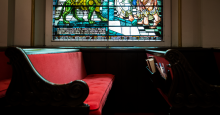stained glass

IN A SERMON that lasted less than 11 minutes, Rev. Wallace Adams-Riley suggested something no one had said from the pulpit in the long history of St. Paul’s Episcopal Church in Richmond, Va.
“What if,” asked Adams-Riley in his faint South Carolina drawl, “we begin a conversation here at St. Paul’s about the Confederate symbols here in our worship space?”
He listed examples: “The Davis window there, that identifies Jefferson Davis with St. Paul himself, in his imprisonment. Or the Lee windows there, that identifies Robert E. Lee with Moses,” he said, pointing around the sanctuary. “And there are the plaques on the walls, and two kneelers up by the old high altar. They [the kneelers] each have a little Confederate flag on them.”
The sermon was remarkable in its restraint. It wasn’t a jeremiad against the church that had, up until the 1960s, emblazoned its official stationery with “Cathedral of the Confederacy.” Nor did it mention the words that would ripple through the congregation in the months that followed, words like “racism,” “slavery,” and “reconcile.”
In fact, there weren’t many words at all. Adams-Riley’s preaching style is spare and impressionistic; his tone, much like his personality, gentle and encouraging. He quoted the Wisdom of Solomon: “The generative forces of the world are wholesome, and there is no destructive poison in them.”
“Generating. Building up. Giving life,” repeated Adams-Riley. “Strengthening. Healing. Bringing wholeness. That is what God does. And we, being made in God’s image, find our greatest fulfillment in doing likewise.”

More than 40 years have passed since Sally Priesand was ordained as the first female rabbi in the U.S. Since then, more than 800 female rabbis — including 647 in the Reform movement — have graduated from several seminaries, including my daughter Eve.
Even so, Jewish and Christian clergywomen still face visible and invisible obstacles in their careers. Call it the persistent stained-glass ceiling. Some barriers are major in nature; some minor.
A male rabbi, minister or priest might be praised for being “assertive” and “ambitious” as he climbs the slippery ladder of success in American religious life. But women who possess similar qualities are dubbed “brash” or “arrogant.” Male clergy can be “dynamic,” while women with the same qualities are often termed “strident.”